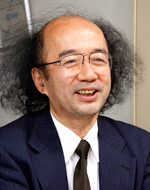2010/06/02
Creating artificial intelligence as good as human intelligence
Professor Kei Hiraki
(Department of Creative Informatics)

“Realizing the world fastest computer and communication” ---- Professor Hiraki' s target is clear and straightforward. He is opening up the door to the new age of ultrafast speed through developing “petaflops” scale supercomputers that perform 1,000 trillion calculations per second and fostering competencies to use 10Gbps ultrafast networks. He foresees that “zeta (10 to the power of 21) flops” scale supercomputers, which is 1 million times faster than peta, will be available around 2030 and its roadmap is already designed. Why does he eagerly await such fast supercomputers? It is his aspiration “to advance science and create true artificial intelligence using the machine.”
“Peta” speed is useful for solving unexplained phenomena in science technology including life science, astronomy, nanoscience, weather, global environment, and advanced designs such as aircrafts and automobiles. The most important aspect is to be able to lead the new age in which simulations and experimental science are leveraged together. Professor Hiraki was among the first to develop “peta machines” for that purpose. Although the development of a peta machine usually requires enormous investments, he demonstrated that it could be developed with an investment that is two digits less than normal development costs. However, “peta” performance is still not enough. Artificial intelligence that is as good as human cannot be developed without supercomputers that are as fast as human brains. That is why zeta machine is necessary.
Computer history began with “ENIAC” in 1946. Performance improved exponentially by 1.8 times every year over the last 60 years. Professor Hiraki believes that this scenario “will continue till the time of zeta machines.” He expects that, by design rule, around 2015 an exa (10 to the power of 18) machine with 16nm CPU and around 2030 a zeta machine with 5-10nm CPU will be realized, respectively. System researchers must have such eyes to perceive future speed. This is the view of Professor Hiraki as a typical computer scientist who dedicates himself to parallel processing research.

